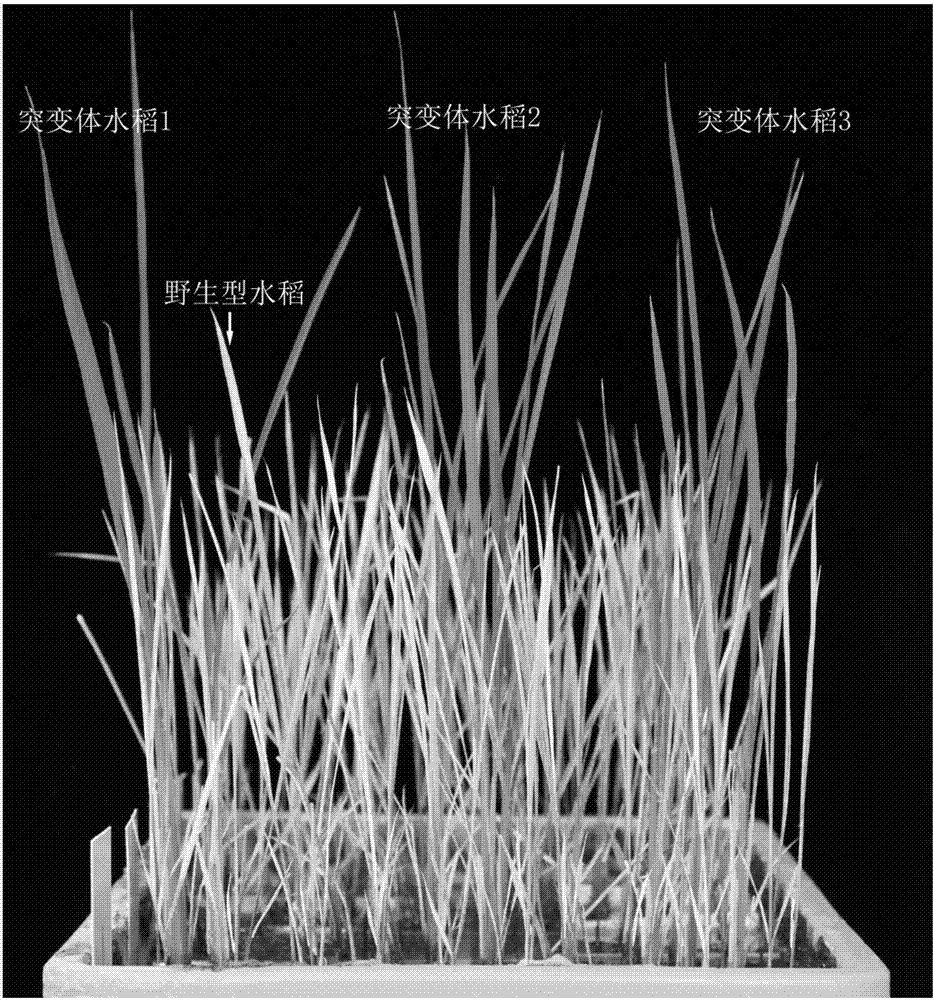Paddy rice herbicide resistant protein and gene as well as application of protein and gene
A herbicide-resistant and herbicide-resistant technology, applied in the fields of application, genetic engineering, plant genetic improvement, etc., can solve the problems of serious weed damage, no resistance, and herbicides cannot be applied, and achieve good application prospects
- Summary
- Abstract
- Description
- Claims
- Application Information
AI Technical Summary
Problems solved by technology
Method used
Image
Examples
Embodiment 1
[0044]First, take 5 kg of rice seeds of the Huahang 31 strain, soak the seeds in clean water for 16 hours in a 28°C constant temperature incubator, remove the seeds and control the water. The seeds were again treated with 1% (w / w) ethyl methanesulfonate in a constant temperature incubator at 28° C. for 8 hours, and the seeds were taken out and dried. Rinse the seeds with clean water, change the water 8 times, germinate and sow at 37°C, and harvest 300 kg of Huahang 31 mutagenized M1 seeds.
[0045] Then, the harvested M1 generation seeds were sown at a high density, and when they grew into 3 to 4 leaves, the field was sprayed with a concentration of 3.33% Bean Xerox (which contained 5% by weight of imazethapyr). Three imazethapyr-resistant mutant plants died. Such as figure 1 As shown, after 25 days of spraying Dou Xerox, it can be found that the mutant rice 1, 2 and 3 did not grow poorly or withered and died, and all grew well; while the wild-type rice had all died.
[004...
Embodiment 2
[0049] This embodiment is used to detect the activity of anti-herbicide protein and wild type ALS protein as shown in SEQ ID NO.2, SEQ ID NO.3, SEQ ID NO.5, and sulfonylurea herbicide, imidazolinone Class herbicides, triazolopyrimidine herbicides and salicylic acid pyrimidine herbicides are shown in SEQ ID NO.2, SEQ ID NO.3, SEQ ID NO.5 anti-herbicide protein and wild-type ALS protein Inhibition rate of in vitro activity.
[0050] After 5 g of leaves of Huahang 31 mutant plants 1, 2, 3 and wild-type Huahang 31 plants obtained in Example 1 were chopped up, 10 mL of potassium phosphate buffer solution (pH 7, containing 1 mM sodium pyruvate, 50 mM, 0.5mM magnesium chloride, 0.5mM TPP and 10μM FAD) and quartz sand were ground to obtain a ground mixed material; the ground mixed material was filtered using 8 layers of gauze to obtain a filtrate; Centrifuge at 20,000rpm for 30 minutes, take the supernatant; add ammonium sulfate to the supernatant to make it reach 50% saturation, the...
Embodiment 3
[0056] This example is used to verify that transgenic plants expressing the herbicide-resistant protein shown in SEQ ID NO.2, SEQ ID NO.3 or SEQ ID NO.5 are resistant to sulfonylurea herbicides, imidazolinone herbicides, Resistance to triazolopyrimidine and salicylic acid pyrimidine herbicides.
[0057] Use the primers shown in table 2 to SEQ ID NO.8 and SEQ ID NO.9 to amplify the herbicide-resistant protein coding genes of the 3 mutant plants in Example 1, sequence the nucleotide sequences of the 3 genes, and The three genes were constructed into the pCAMBIAI1301 vector and the Agrobacterium EHA105 transformed into the recombinant plasmid was obtained by electroporation, and the three recombinant plasmids were respectively transformed into wild-type Huahang 31 plants using the Agrobacterium-mediated transformation method. Three kinds of transgenic plants expressing herbicide-resistant proteins were obtained by PCR amplification and sequencing screening in T0 generation tissue...
PUM
 Login to View More
Login to View More Abstract
Description
Claims
Application Information
 Login to View More
Login to View More - R&D
- Intellectual Property
- Life Sciences
- Materials
- Tech Scout
- Unparalleled Data Quality
- Higher Quality Content
- 60% Fewer Hallucinations
Browse by: Latest US Patents, China's latest patents, Technical Efficacy Thesaurus, Application Domain, Technology Topic, Popular Technical Reports.
© 2025 PatSnap. All rights reserved.Legal|Privacy policy|Modern Slavery Act Transparency Statement|Sitemap|About US| Contact US: help@patsnap.com

